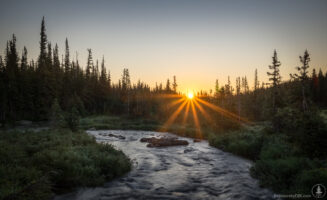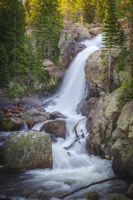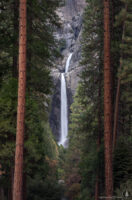Originally posted on Facebook.
The below photograph was taken recently up in Rocky Mountain National Park. It’s a 10 shot panoramic at dawn as the moon was setting. While I don’t do a lot of panos I thought I’d post my process in case it gives others any ideas; if you have questions or additional ideas, please share as well!
I live near RMNP and with the full moon I wanted to see how things may line up. The night before, using the photographer’s ephemeris app, I looked at when the moon would set and how it would be positioned at a few spots I had in mind around the park. I picked what I thought was the best one and arrived there about 30 minutes before sunrise (there were some others that would have required a longish hike or the moon would have fallen behind the mountains too early).
I knew I wanted the moon in the scene as well as Longs Peak (far left of the shot). To set up this landscape panoramic, I oriented the camera in portrait format and first framed up the shot with the moon. All settings were set to manual so they wouldn’t change as I panned the camera to areas of the scene with different light – manual focus, manual white balance, and exposure settings. The shot with the moon would be the brightest so I experimented with that one first to get it dialed in (I kept the histogram a little to the right knowing most of the scene would be darker and I didn’t want it to go too dark). The moon was bright enough that it was still blown out with the rest of the scene. So, I first took one shot underexposed by 5 stops to get the moon correctly exposed (or close at least), then I quickly took another shot with the correct exposure I had previously determined.
I then continued to pan over the scene, overlapping each shot by about one third (ball head on the tripod was locked down and I moved the head via the pan lock). I did 10 shots in total to cover the scene.
For editing, I imported everything into Lightroom (LR) and then exported the first two shots (for the moon) into Photoshop (PS) (edit in PS with layers). I added an adjustment layer to the top layer (the shot with the overall scene exposed correctly) and tried to mask out the moon to show the correctly exposed moon underneath. I honestly wasn’t very optimistic and sure enough it didn’t quite work. The main issue was the moon had moved just enough as to not line up.So I first removed the overexposed moon via the heal tool then masked for the moon in it’s slightly shifted location. From there, I saved back into LR, made some adjustments to one of the 10 images (whites, blacks, contract, clarity, vibrance), synched the images so they’d all have the same settings, and then again edited in Photoshop via the panoramic merge function. Auto align and let PS do its magic. Cropped the final image and saved back to LR.
Overall, I’m happy with it. A little more dramatic light would have been welcomed, but it was a great morning to be out and I was happy just to be out shooting.
A few other notes: I didn’t have a level on my tripod which caused some issues on one series I took as they weren’t straight across. Second, I know an actual panoramic tripod that shifts the camera around the nodal point is the better way to go, but for now as I don’t do that many panoramic shots, I don’t have one in my toolbox.

Details: Pentax K-5, Sigma 70-200 f/2.8 shot at f/5, 70mm, .6s, on a Manfrotto tripod and ball head.




